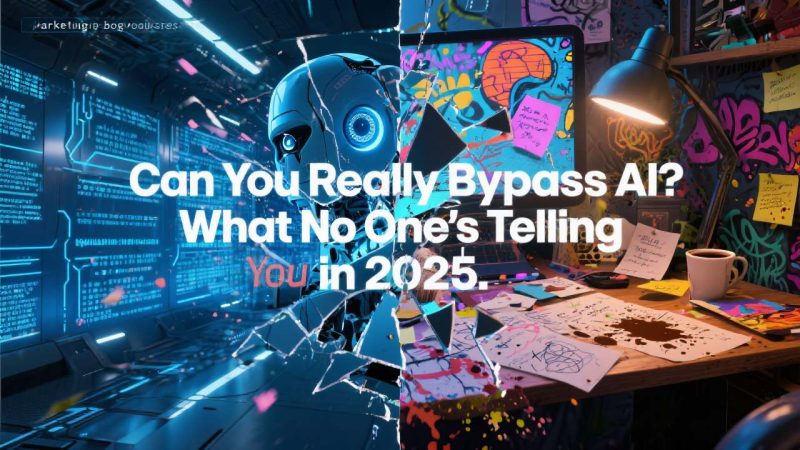
AI doesn’t just knock anymore – it has the keys, walked right in, shuffled your calendar, replied to that awkward text from your mother-in-law, and yes, probably helped write part of this very sentence. It’s no longer some far-off concept or a looming threat on the horizon. It’s embedded in nearly everything we touch, expected, unavoidable.
And now, murmurs spread quietly through Slack channels, forums, and whispered conversations: Can you bypass AI?
What Does “Bypass AI” Even Mean?
That depends entirely on who’s asking. For some, bypass ai means slipping through the mesh of detection tools – the ever-watchful algorithms trained like bloodhounds to sniff out machine-generated text. They look for signals: overly uniform sentence length, repetitive vocabulary, and a cold absence of emotional nuance. Tools like GPTZero or Turnitin don’t read for meaning; they scan for robotic fingerprints lurking beneath the words.
For marketers juggling deadlines and a mountain of content, bypassing AI means something else entirely – it’s about breathing life into cold, mechanical prose. A typo here, an unexpected analogy there, a little messy humanity scattered throughout, transforming sterile text into something relatable, something that feels like it was typed by a person in a noisy café – not spat out by a silicon brain.
And for students, staring down the barrel of a deadline, bypass AI becomes survival – an attempt to sneak machine-generated work past scrutiny without raising alarms.
But the question lurking beneath all of this isn’t just how to bypass AI – it’s why so many want to.
The AI Detection Arms Race
AI’s uncanny ability to mimic human language forced the creation of detectors designed to expose it. GPTZero, Turnitin, OpenAI’s watermarking tech – they all slice through writing with forensic precision, hunting for patterns. It’s never about content or style; it’s about repetition, mechanical pacing, and emotions that read like a textbook definition rather than a lived experience.
Suddenly, every AI-written word was a suspect.
And the response? A new breed of disruptors emerged – copywriters, SEO specialists, students, and developers who began crafting ways to bypass AI detection. Not by hacking algorithms, but by injecting deliberate chaos. Intentional typos. Sentence fragments. Emotional shifts that defy logic but somehow feel right. Contradictions, quirks, imperfect rhythm.
It became a war waged in language itself.
Bypassing AI Detection Isn’t Science – It’s Art
Forget formulas or guaranteed hacks. Bypassing AI detection is improvisation. Think of a jazz solo riffing wildly off a classical sheet music – sometimes a perfect harmony, sometimes a deliberate discord.
Take a pristine AI draft, add irregularities, break predictable rhythms, throw in a metaphor that doesn’t quite land – and sometimes, that’s all it takes to slip under the radar. Other times? No tweak can fool the system.
Why? Because AI writes in neat, straight lines. Humans spiral. We start a thought, abandon it halfway, contradict ourselves, and lace our speech with rhythm rather than rigid grammar.
That messy, glorious human element? It’s what AI detectors can’t quite pin down yet.
The Ethics of Using AI and Bypassing Detection
This topic isn’t black and white.
Yes, it’s tempting to let AI draft a piece when time’s tight, then polish it enough to sneak past detection. But when does “smart use” turn into dishonesty?
For students, it’s a risky gamble. The fallout could be plagiarism accusations or worse.
For brands, it’s a trust issue. Imagine customers learning that a heartfelt founder’s story was actually generated by an algorithm – it can quickly erode credibility.
For marketers and creators, AI is just another tool – like spellcheck or Grammarly – that speeds up workflow. The difference? Transparency and integrity. Using AI to assist, then adding your own voice, isn’t cheating. It’s collaboration.
The real misstep? Pretending AI wasn’t part of the process.
So, What’s the Best Way to Bypass AI?
Here’s the twist: the most reliable way to bypass AI detection isn’t some secret software trick. It’s writing like a human – messy, unpredictable, imperfect.
It’s in sentences that meander, metaphors that falter, abrupt tonal shifts, contradictions we all fall into naturally.
AI writes with precision. Humans write with hesitation, tension, nuance. We repeat ourselves. Backtrack. Ramble.
That chaotic humanity? That’s the secret no algorithm’s cracked yet.
Final Thoughts
As AI writing tools evolve and detectors sharpen, this cat-and-mouse chase will continue. But mastering the balance between leveraging AI and preserving authentic human voice? That’s the real key.
If you want to bypass AI without losing credibility, embrace imperfection. Write like a person – flawed, curious, emotional.
Because, at the end of the day, what machines can never replicate is the noisy, beautiful imperfection of the human mind.
